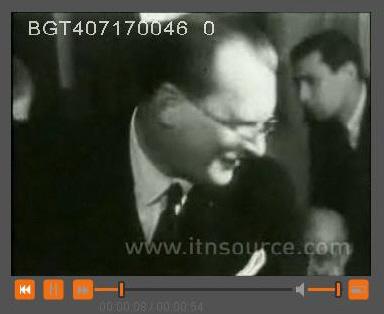
Edward Winter

Alexander Alekhine
Which was the first occasion when chess masters were filmed? The earliest case that comes to mind is the New York, 1915 tournament. From page 91 of the May-June 1915 American Chess Bulletin:
‘… a genuine chess scene, and nothing less than the opening round of this tournament, was reproduced in motion pictures at various theaters throughout the country. On 17 April, on the invitation of the Messrs Pathé-Frères, the players, committee men and other prominent followers of the game repaired to the studio at the plant of that well-known concern and, under the direction of Mr Raymond J. Brown, the editor of Pathé News, posed before the camera which produced the films that were to make the public at large better acquainted with chess, and some of its chief exponents. In the principal sitting, the players were shown seated as paired in the opening round, making their moves, regulating clocks and recording scores, with officials and spectators grouped in the background. In addition, there were separate sittings for Capablanca and Marshall in individual poses.’
(2220)
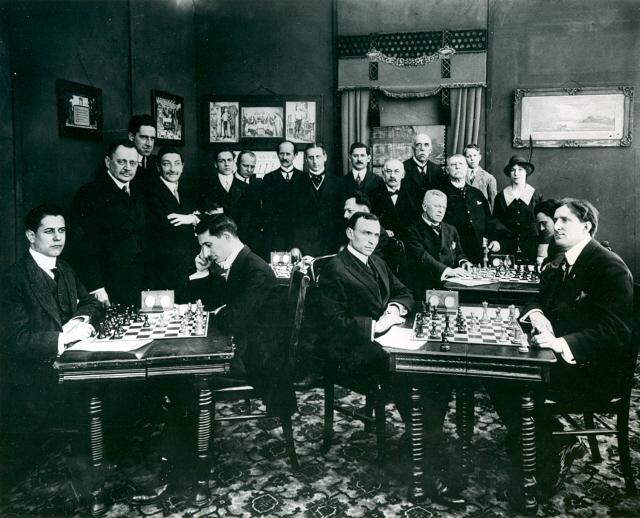
John Blackstone (Las Vegas, NV, USA) draws attention to page 3 of the Brooklyn Daily Eagle, 22 April 1915, which has a caption for the above photograph. The newspaper also reports on the film coverage featuring Capablanca, Marshall and other masters. See the addition to New York, 1915: A Chess Photograph.
(6921)
A related question: who was the first chess master to act in a film? We suggest A.B. Hodges (1861-1944), who was the subject of a brief item entitled ‘Hodges in the Movies’ on page 47 of the February 1918 American Chess Bulletin:
‘Albert B. Hodges, ex-United States chess champion, has made a number of appearances on the screen, notably as a member of the Russian Duma in War Brides, the Police Inspector in The Auction Block, the Coroner in Empty Pockets and the Butler in the new Brenon picture False Faces.’
Albert Beauregard Hodges
(2221)
David Picken (Greasby, England) writes:
‘I have searched in the Internet Movie Database and the All Movie Guide database but have found nothing on Hodges, although the four films you mentioned are covered and cast-lists are given. It may be that Hodges was an “extra” or a very small bit part player who would not normally be credited. The films are:
War Brides. Released in 1916 as a short (eight minutes) by Selznick Pictures Corporation and directed by Herbert Brenon. The cast included Alla Nazimova and Richard Barthelmess.
The Auction Block. Released in 1917 and directed by Laurence Trimble.
Empty Pockets. Released in 1918 and directed by Herbert Brenon.
The False Faces. Released in 1919 and directed by Irvin Willat. Brenon appears not to have had a connection with this film.’
(3813)
All available information on this aspect of the master’s life is presented on pages 314-315 of an admirable new book, Albert Beauregard Hodges (subtitle: The Man Chess Made) by John S. Hilbert and Peter P. Lahde (Jefferson, 2008).
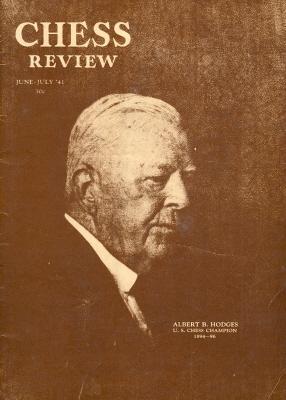
A.B. Hodges, front cover of the Chess Review, June-July 1941
(5737)
‘According to H.A. Horwood of Los Angeles, Cal., in the October “Folder” of the Good Companion Chess Problem Club, Carlos Torre, R., the boy expert of New Orleans, like Rzeschewski, has appeared in the “movies”.’
Source: American Chess Bulletin, November 1920, page 176.
No further information has yet been found, and for now we can but add the exact text in the earlier publication:
‘H.A. Horwood, Los Angeles, Calif. “These are wonderful days for chess, as I saw last evening, in a moving picture theatre, an exhibition of our boy wonder, C. Reperto [sic], of New Orleans.”’
Source: “Our Folder”, 1 October 1920, page 11.
(4862)
From the report on page 64 of the February 1931 BCM, regarding the Hastings, 1930-31 tournament (at which Capablanca lost to Sultan Khan):
‘A “movietone” was taken of the proceedings one morning, but Capablanca was not “in the picture”. A good joke was provided by the wife of one of the chess correspondents, who wrote to her husband thus: “I have been reading the chess reports (not her husband’s, by the way) and I notice that the Aga Khan has beaten Capablanca.” Nobody enjoyed this one more than Capablanca.’
(Kingpin, 2000)
Footage of old events (such as living chess displays featuring Capablanca and Alekhine, against Sir George Thomas and Bogoljubow respectively) can be viewed at the following site: http://www.britishpathe.com/.
(3491)
From Luc Winants (Boirs, Belgium):
‘British Pathé footage (www.britishpathe.com) is now managed by ITN Source (www.itnsource.com). There also seem to be clips from other companies, such as Gaumont.
One brief item is of a simultaneous display given by Alekhine in Paris (most probably the one on 28 February 1932 – see pages 416-417 of the book by Skinner and Verhoeven): www.itnsource.com/shotlist//BHC_RTV/1932/01/01/BGT407170046/?s=Paris+chess&st=0&pn=1
Another one, even more spectacular, shows the tournament in San Remo, 1930. We see them all: Alekhine, Nimzowitsch, Spielmann, Maróczy, Yates …: www.itnsource.com/shotlist//BHC_RTV/1930/01/01/BGT407150379/?s=Alekhin&st=0&pn=1’
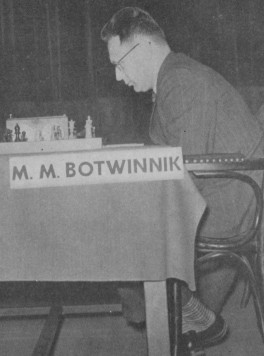
Mikhail Botvinnik
Page 249 of the August 1948 CHESS stated:
‘We hear that Mikhail Botvinnik is the subject of a new Russian documentary film, World Champion.’
What more is known about it?
(3823)
There used to be considerable ignorance about the 1925 Soviet film Chess Fever. ‘Did any reader ever see it?’ was the question posed on page 76 of CHESS, 5 December 1959. The same page contained the remark ‘Capablanca’s voice and figure were, we understand, “dubbed in”’, which Stewart Reuben corrected on page 283 of the 18 June 1960 issue by pointing out that the film was made before the advent of sound.
But in what circumstances was the footage of Capablanca included? In the Chess Fever entry on pages 72-74 of Chess in the Movies Bob Basalla writes:
‘“Capa” was actually given “star” billing to goose audience attendance, even though most of his “acting” is just edited in to make him look like a participant. (The technique of Pudovkin’s mentor, Lev Kuleshov, by which unsuspecting people, in this instance the tournament participants and especially World Champ Capablanca, are filmed documentary or news reel style only to have their “parts” spliced into a different movie, a comedy in this case, defines the Kuleshov method.)’
Does contemporary Soviet literature (chess, cinema or general) offer any clarification of what occurred?
Nowadays, Chess Fever is widely available for home viewing.
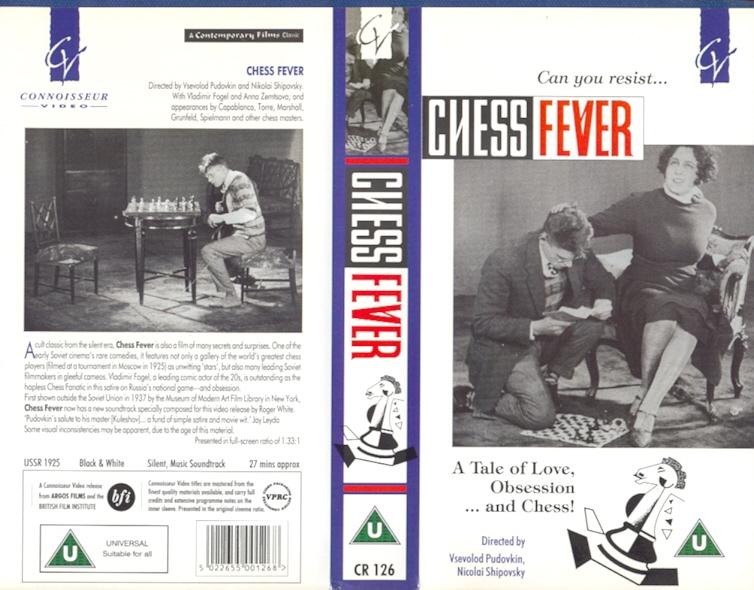
Hassan Roger Sadeghi (Lausanne, Switzerland) writes:
‘I very much doubt that what was said about inserting Capablanca in Chess Fever could be true. He interacts with the leading actress in the plot of the film, unlike the other masters, who are indeed merely sitting at their boards.’
This interaction is also mentioned in Bob Basalla’s book Chess in the Movies. As regards the other masters, it may be noted that the set of pairings filmed (e.g. Marshall v Torre and Réti v Yates) corresponds to no round of play at Moscow, 1925, and there is much artificial smiling for the camera. Another point is that the cinema entry in The Encyclopedia of Chess by H. Golombek (London, 1977 and Harmondsworth, 1981) stated that the director, Pudovkin, utilized ‘such real personages as Capablanca and Lasker as figures in his short film’, whereas Basalla writes (justifiably, from our own viewing), ‘I can’t see where Emanuel Lasker appears at all’.
(3992)
Olimpiu G. Urcan provides an extract from pages 174-175 of Kino: A History of the Russian and Soviet Film by Jay Leyda (New York, 1960):

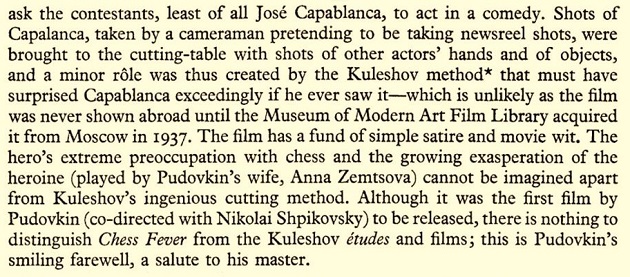

(10931)
John Blackstone sends this report from page 26 of the Brooklyn Daily Eagle, 14 January 1935:
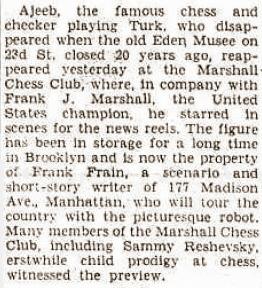
Can any reader discover whether the footage has survived?
Page 219 of Chess: Man vs Machine by Bradley Ewart (London, 1980) stated:
‘Under Frain’s guidance Ajeeb was reintroduced to the world in early January 1935. At that time the automaton, “rigged out anew in resplendent oriental regalia”, posed for a newsreel troupe at the Marshall Chess Club with US Champion Marshall himself. Frain later claimed that Marshall “encountered Ajeeb at chess, and went away shaking his head after a draw”.’
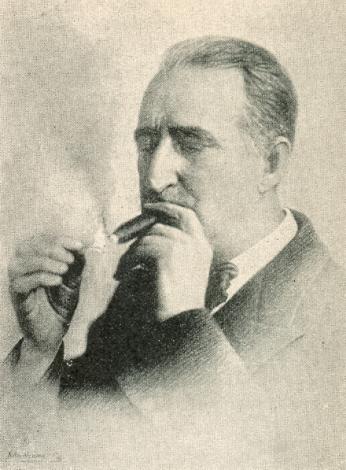
Frank James Marshall (American Chess Bulletin, December 1935, page 171)
(6527)
Robert Sherwood (E. Dummerston, VT, USA) asks for information about the film referred to by W. Hatton Ward on page ix of his Introduction to Alekhine’s book on the London, 1932 tournament:
‘For a whole fortnight a Chess Congress held its ground as a popular London spectacle, and the enormous publicity secured was as advantageous to the game - possibly more so - as to the newspaper. Admission was free upon production of a ticket, and in addition to the usual army of photographers a sound film of the opening ceremony was taken by the Gaumont Coy., Ltd., and was exhibited at a large number of London and provincial cinema theatres.’
(6760)
Ryan Paulis (Amsterdam) informs us that much Euwe-related footage is now available on-line, including an unmissable item which features Capablanca speaking.
[Addition on 11 March 2012: Since the above link no longer works, we provide the general link to the website. For a direct link to the Capablanca interview, see C.N. 7550.]
(6862)
Since the link to the Geschiedenis 24 website given in C.N. 6862 required updating, we take the opportunity to provide here a direct link to the only video-and-sound interview with Capablanca known to us. [Further update on 6 December 2019: at present, the best available link appears to be on YouTube.]
(7550)
Addition on 28 September 2024: a different direct link is now necessary.
Further to the above items, we are grateful to Olimpiu G. Urcan (Singapore) for these screen-shots of Capablanca and Euwe with Han Hollander (1886-1943)
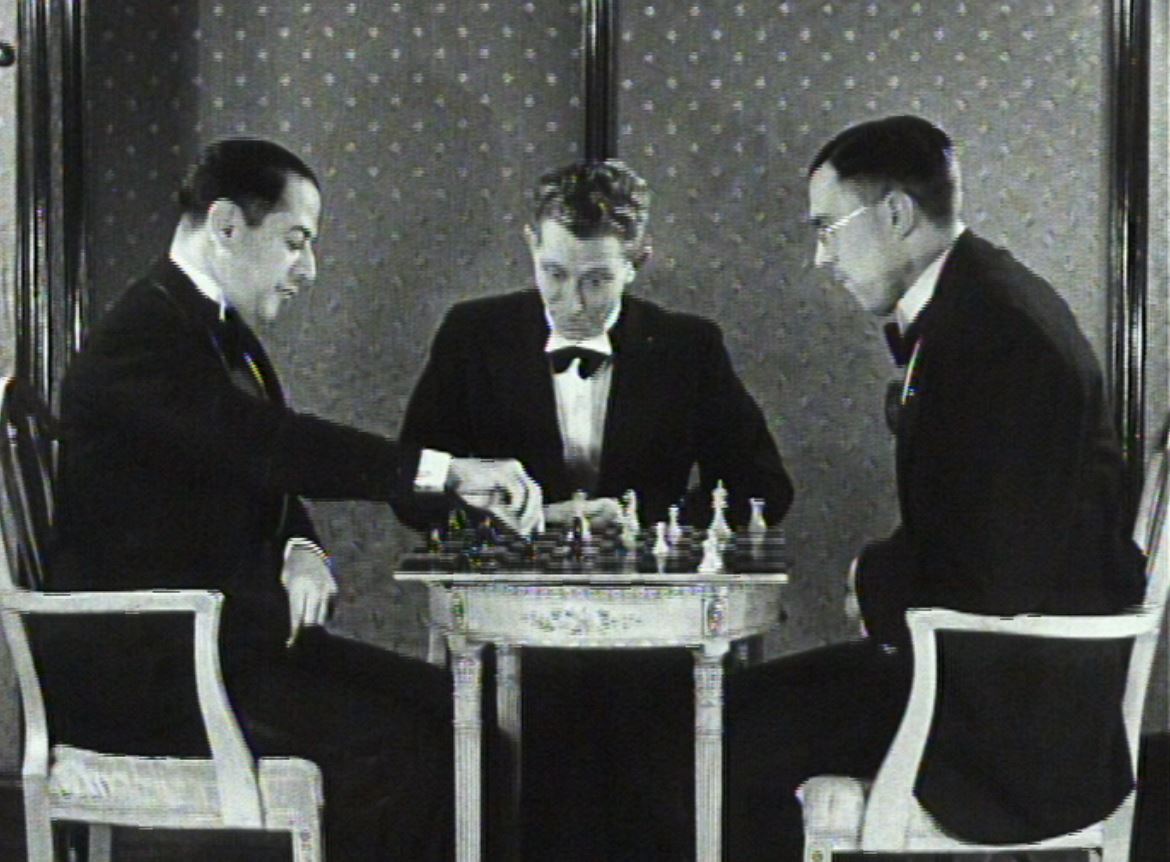
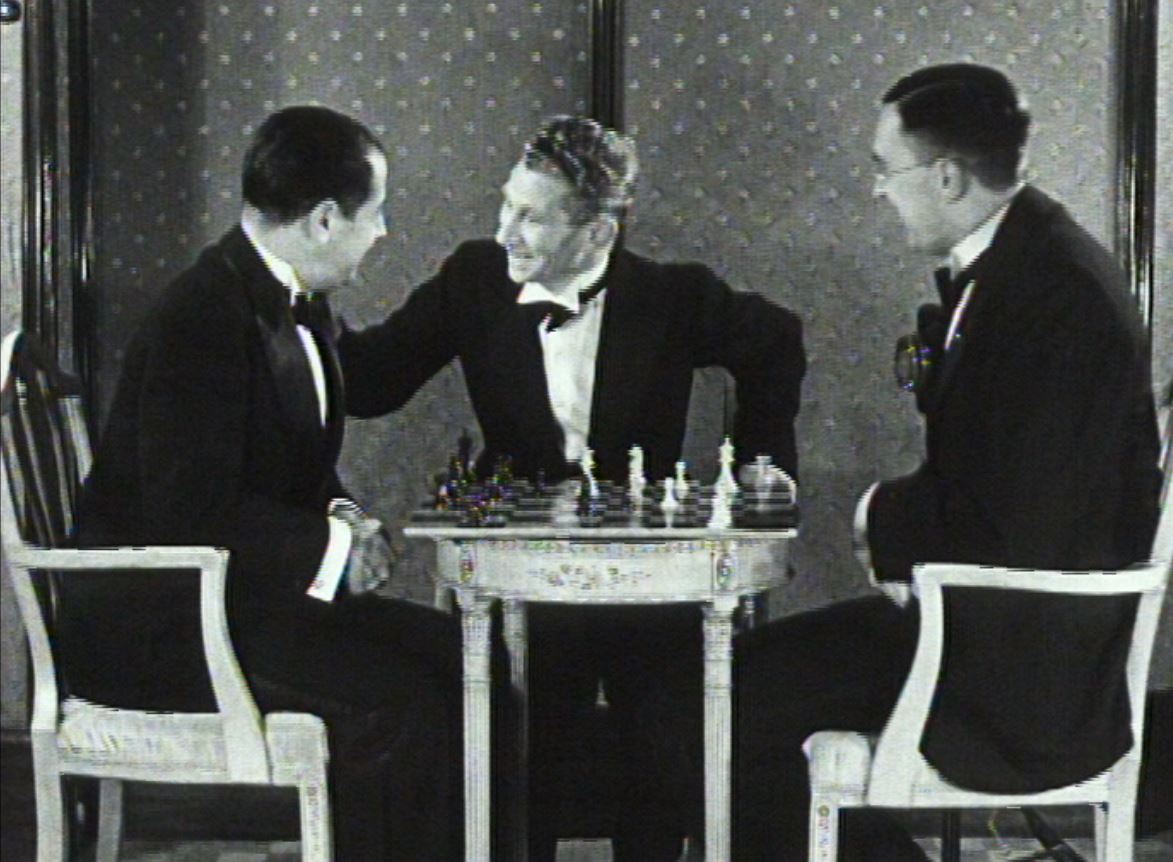
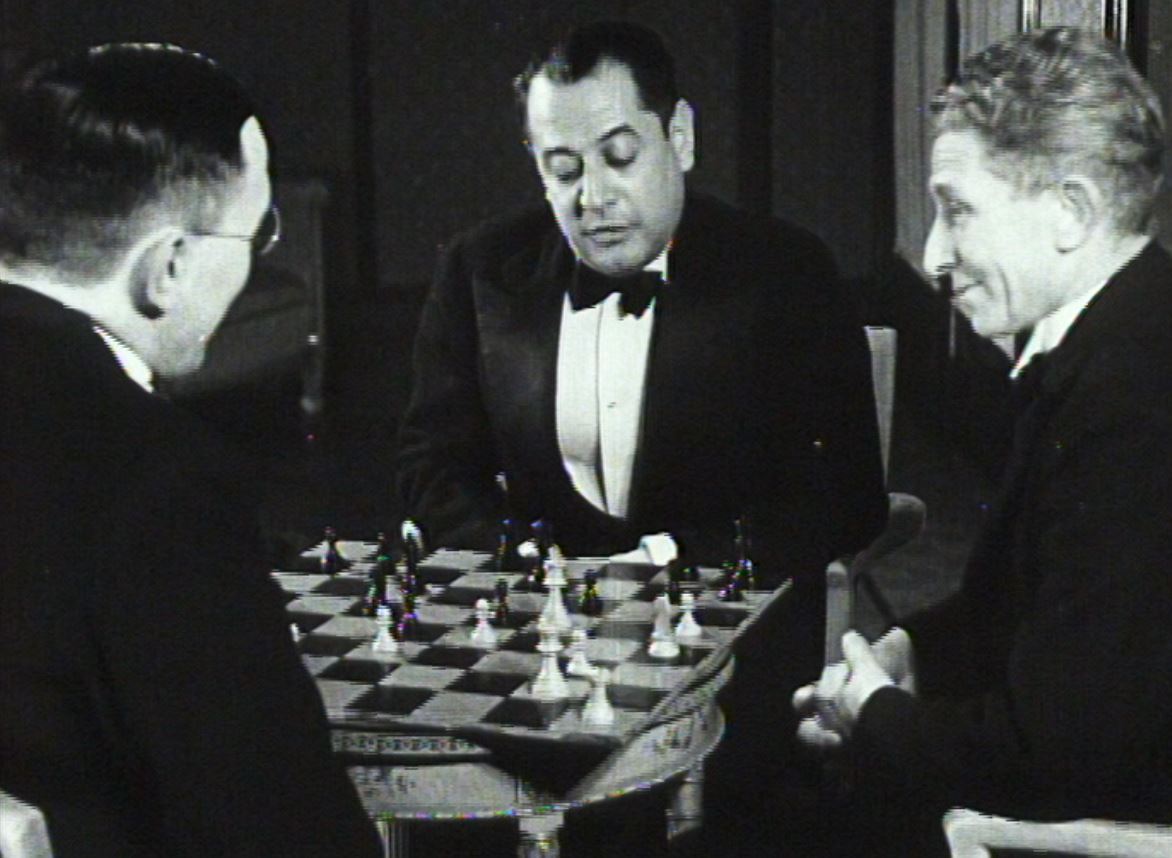
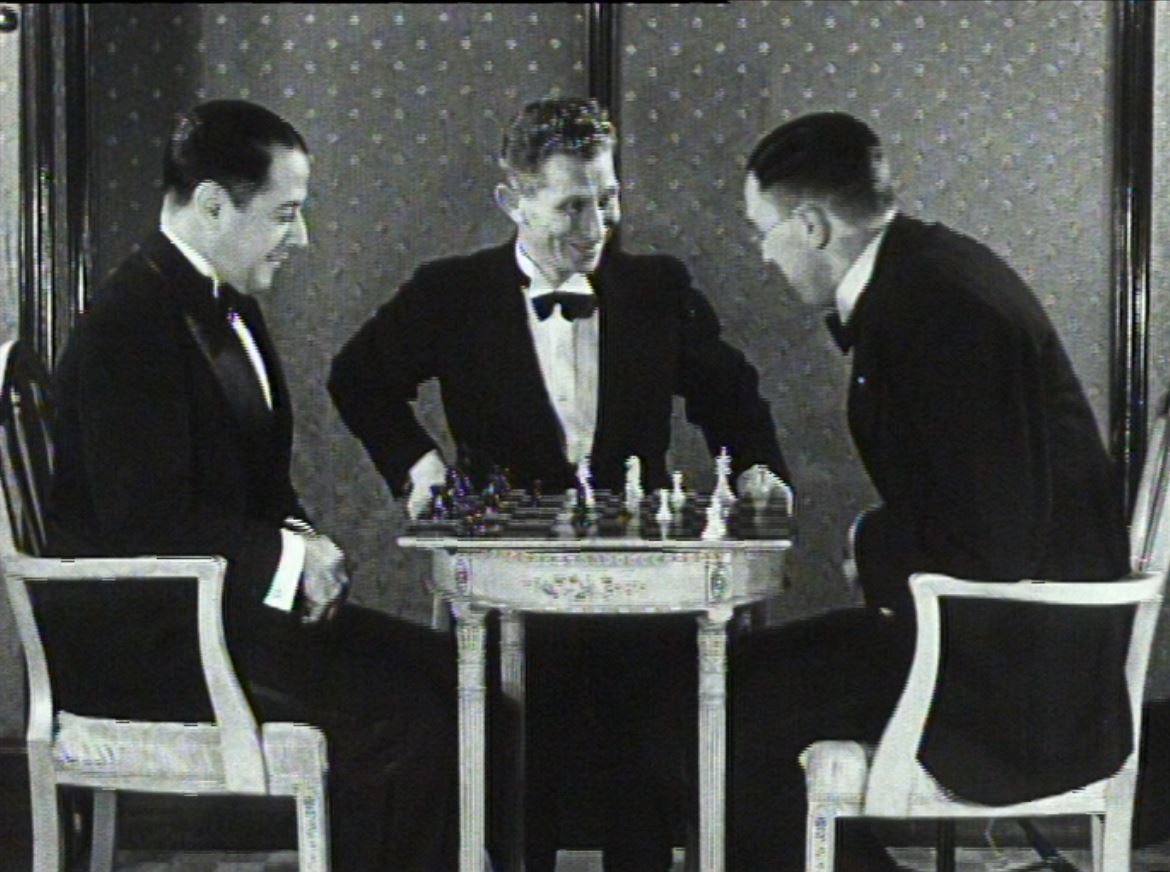
Olimpiu G. Urcan informs us that he has acquired from the Netherlands Institute for Sound and Vision the right to post on his Patreon webpage a brief audio file of Capablanca speaking in English during the AVRO tournament, on the occasion of his 50th birthday (19 November 1938).
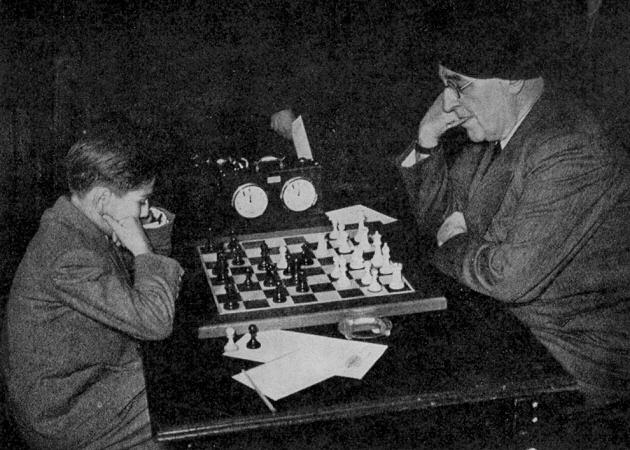
Olimpiu G. Urcan notes a Pathé news item on the London, 1946 tournament, featuring Arturo Pomar in play (with the black pieces, as in the photograph above) against Ossip Bernstein, as well as footage of some other players, including Savielly Tartakower (briefly) and William Winter. The technical quality is good, with a commentary which is quintessentially English.
Another Pathé report pointed out by Mr Urcan concerns Jutta Hempel.
(6978)
In C.N. 6180 Gene Gnandt (Houston, TX, USA) gave a YouTube link to Isaac Kashdan’s appearance on the television show You Bet Your Life, presented by Groucho Marx. That link no longer works, but our correspondent provides a replacement one, to the Internet Archive.
(7072)
Robert Sherwood draws attention to a snippet of film showing Alekhine and Euwe at the chessboard (the first part of the item).
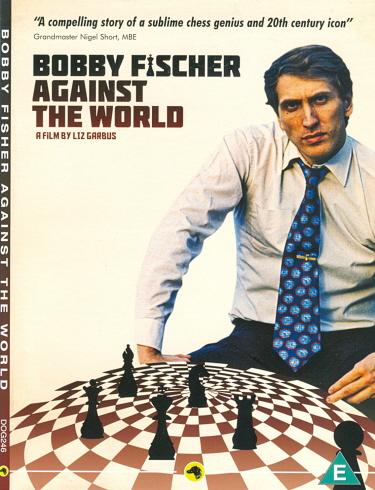
C.N. 7345 mentioned that Liz Garbus’s 2011 documentary film Bobby Fischer Against the World has some exceptionally rich archive material.
A Canadian documentary of the early 1980s which contained much film of the old-timers was Jouer sa vie/The Great Chess Movie by Gilles Carle and Camille Coudari. See Chess Jottings.
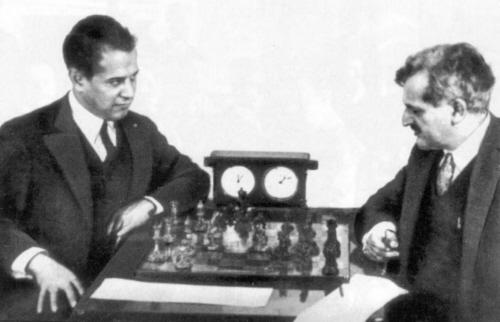
Further to this well-known photograph of Capablanca and Lasker in Moscow in 1925 (see, for instance, page 310 of Chess Facts and Fables), Christian Sánchez (Rosario, Argentina) notes a brief sequence of moving pictures of the two champions (at about 15:40:40).
(7658)
Addition on 16 November 2012: the material is no longer available at the link indicated.
C.N. 6312 showed these three photographs:
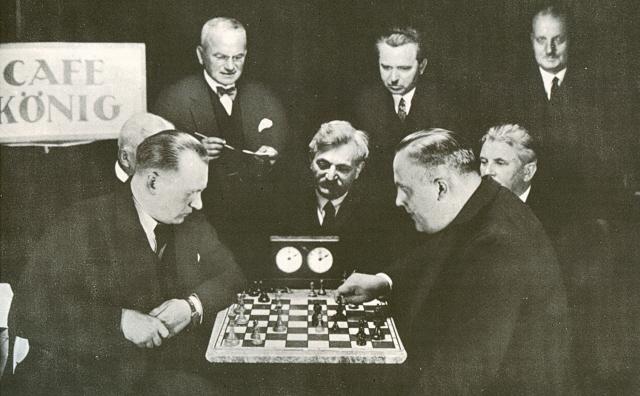
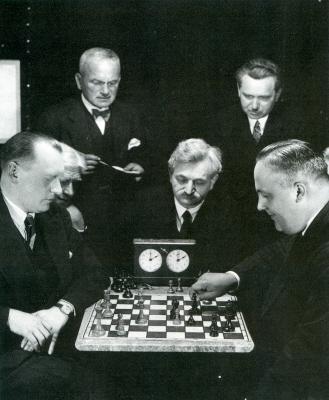
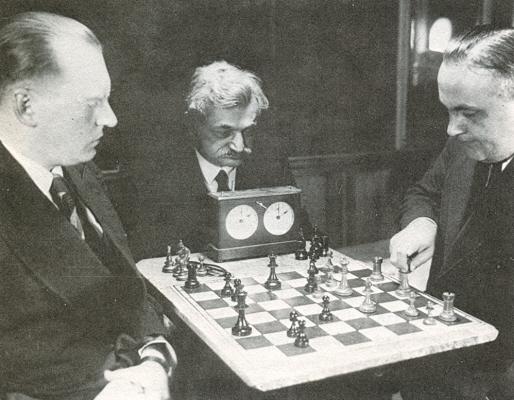
Now, Albert Silver (Rio de Janeiro, Brazil) points out some film footage of the occasion, entitled ‘Campionato di scacchi a Berlino’.
(7724)
Gerhard Thoma (Dornbirn, Austria) draws attention to the 1972 Soviet film Гроссмейстер, which can be watched on-line. Many masters appear, including Petrosian, Korchnoi, Tal and Kotov.
Our correspondent mentions too the observation by Milan Novković that some of the over-the-board action is based on the spectacular draw between Alatortsev and Kholmov in the 1948 Soviet championship in Moscow.
(7747)
Regarding the 1972 film Гроссмейстер Javier Asturiano Molina (Murcia, Spain) quotes from pages 83-84 of Chess is my Life by Victor Korchnoi (London, 1977):
‘In 1972 I happened to do some acting, in a professional studio, for a film. This was a film about chess, and was called Grossmeister (Grandmaster). It told of a boy who became a grandmaster, and I played the role of his trainer. The very fact that a film about chess was made was a good thing. But the film itself turned out to be rather poor. It was not by accident that I was praised as being the best actor in the film. After all, I was playing in a professional company, among some really talented actors. It can happen that way; if the script is primitive, then even the actors have no means of expressing themselves. Nevertheless, the film was a success among chessplayers in the USSR and in Eastern Europe.’
(7753)
From Thomas Höpfl (Halle, Germany) comes a link to a Russian film which contains (starting at about 4’37”) some moving pictures of Emanuel Lasker.
On page xix of the Nottingham, 1936 tournament book W.H. Watts wrote:
‘One of the news-reel men got a few shots of R.H.S. Stevenson rowing Miss Menchik on the University Lake, and the picture appeared for a week in the News item and prompted a draughtsman on a local paper to insert a couple of pen drawings which reminded one of Tom Webster’s drawings of the London, 1922 congress. The first showed R.H.S. Stevenson and Miss Menchik in their boat on the Lake, and the second drawing was similar in motif. It was an imaginary picture of Bogoljubow and Vidmar rowing on the same lake, but the boat had given up the unequal task and had sunk and left the masters sitting on the water with the oars in their hands and a surprised and apprehensive look on their faces.’
Page 8 of CHESS, 14 September 1936 reported:
‘The local news theatre sent a cameraman round to take a few films of the players. R.H.S. Stevenson rowing Miss Menchik round the ornamental lake ... featured at the “pictures” for a week.’
The magazine returned to the subject on page 49 of the 14 October 1936 issue:
‘Our account of Mr R.H.S. Stevenson’s (tournament controller) boating expedition with Miss Menchik, at Nottingham, seems to have been incorrect in one essential particular. From reliable sources we learn that it was Miss Menchik, not Mr Stevenson, who did most of the rowing.’
(8165)
Thomas Höpfl and Dan Scoones (Port Coquitlam, BC, Canada) point out a video item featuring Euwe and Alekhine (1935) which is similar, but not identical, to one available mentioned earlier in the present article.
From Thomas Höpfli there also comes a link to a video report on Arturo Pomar which includes Fischer speaking a few words of Spanish.
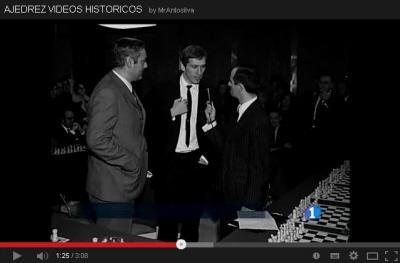
(8201)
From Michael Clapham (Ipswich, England):
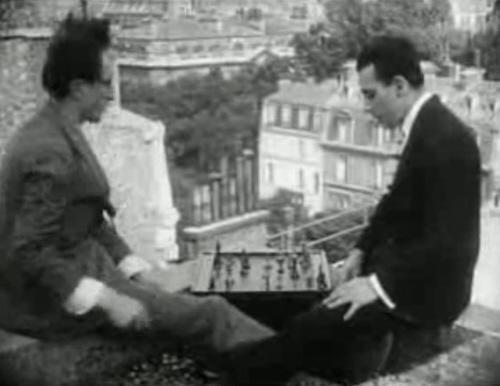
‘Man Ray and Marcel Duchamp played a game of Dadaist Chess in René Clair’s 1924 film Entr’acte. The whole work, about 20 minutes in duration, can be watched on-line. The chess scene starts at 4’29” and lasts about 40 seconds.’
(8366)
Wijnand Engelkes (Zeist, the Netherlands) points out that at the Open Images website a number of Dutch-language film items concerning chess can be viewed by typing ‘schaken’ in the search-box.
Our correspondent mentions too that a search for ‘Euwe’ leads to an item on the 1956 Dutch elections which includes brief footage of the former world champion and provides an opportunity to hear the correct pronunciation of his name.
(8492)
YouTube now offers a large quantity of chess-related footage from Pathé.
(8636)
From page 132 of the February 1926 Chess Amateur:
‘The great interest taken in chess in Czechoslovakia is evidenced by the filming of the opening of the Prague Championship Tournament on 16 January.’
Alan McGowan (Waterloo, Canada) has found film reports on the tournaments at Prague, 1942 (start: 0’30”) and Prague, 1944 (start: 4’05”). The former newsreel, for instance, includes footage of Alekhine and Junge, and we have made these screen-shots:
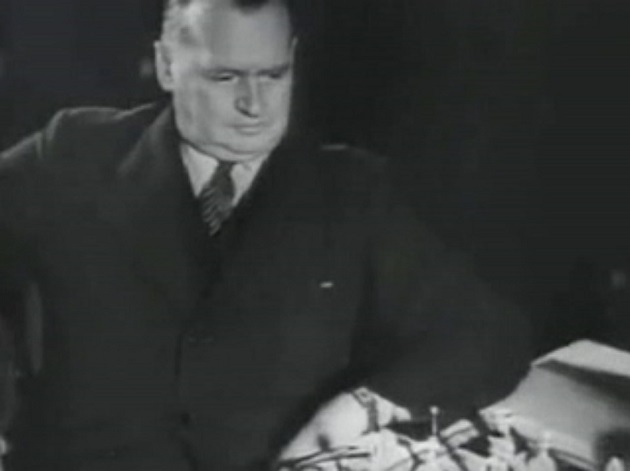
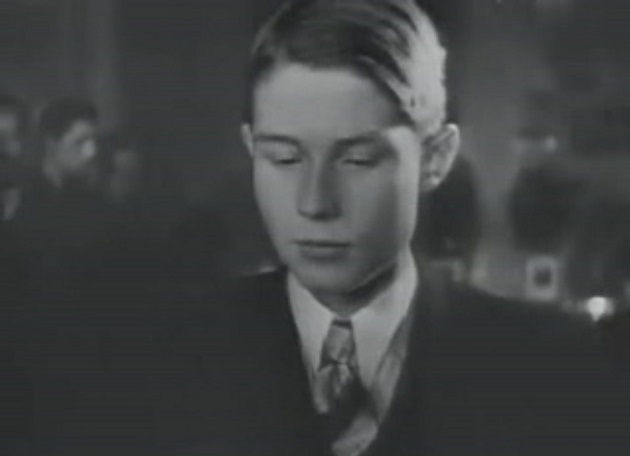
(9289)
From the same site which provided the footage of Prague, 1942 and Prague, 1944 in the previous item, we point out Dutch film reports on the first part of the world championship match-tournament (The Hague, round nine, 23 March 1948) and the first Women’s World Team Tournament (Emmen, 1957).
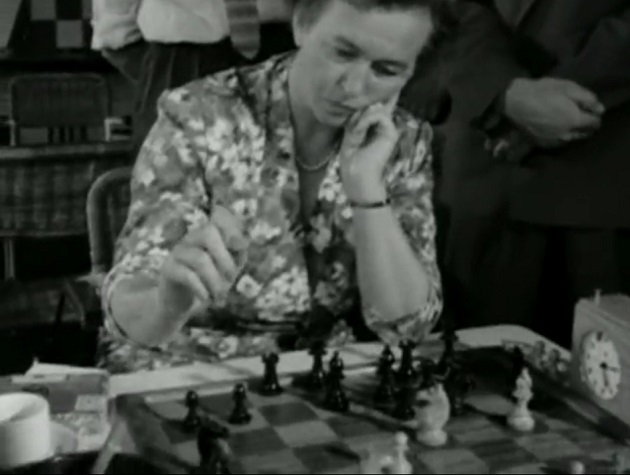
Ingrid Larsen
(9290)
From Olimpiu G. Urcan:
‘The Associated Press and British Movietone have just made available a large volume of archival footage, including much chess-related material. It can be consulted via the Associated Press official archive website and/or YouTube. Some highlights:
Salo Flohr and José Raúl Capablanca in simultaneous exhibitions in Prague, 1935;
Elaine Saunders (aged 11) playing blindfold against her father in 1937;
Hastings, 1963-64 (Tal, Gligorić and Gaprindashvili);
Hastings, 1964-65 (Hindle, N. Littlewood, Gheorghiu and Gaprindashvili);
Petrosian v Spassky world title match, 1966;
Havana, 1966 Olympiad (including Spassky, Fischer and Fidel Castro);
Hastings, 1966-67 (including Botvinnik, Hartston, Balashov, Czerniak and Mecking) plus further footage (with sound commentary) of the participants, with emphasis on Mecking;
- Fidel Castro attending a chess exhibition in 2002.’
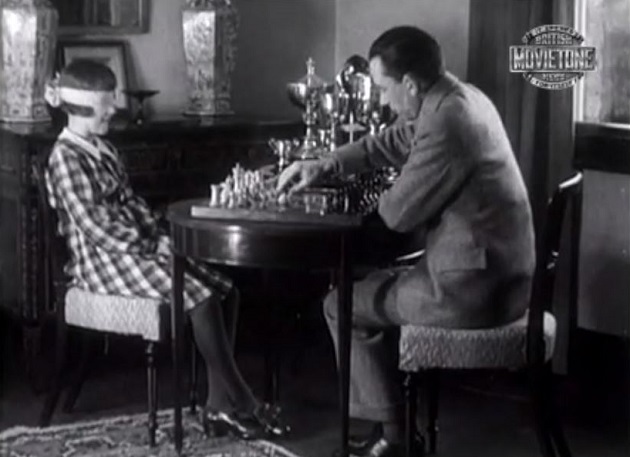
Elaine Saunders
(9390)
Two further stills produced by Mr Urcan from the site mentioned in C.N. 9390:
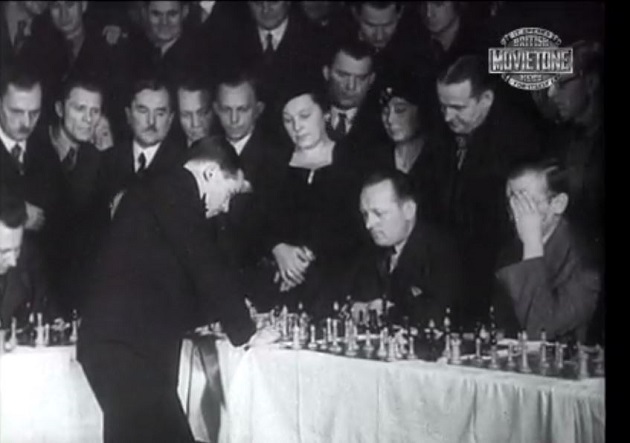
Salo Flohr
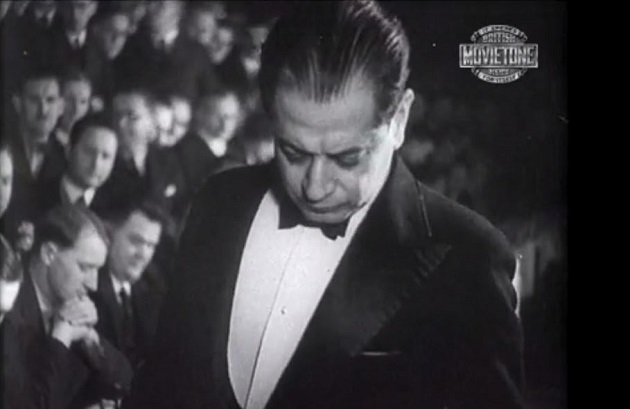
José Raúl Capablanca
Olimpiu G. Urcan also points out a series of links to film coverage of the 1972 world championship match.
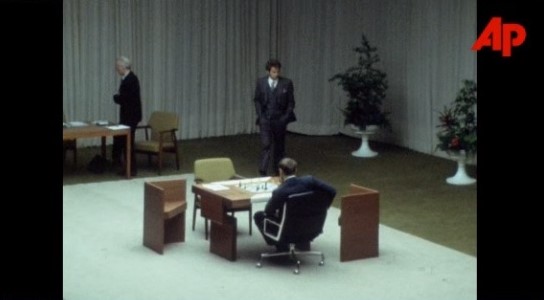
More and more archive film on chess is coming to light, including particularly interesting footage from the Candidates’ tournament, Bled in 1959.
Two screen-shots:
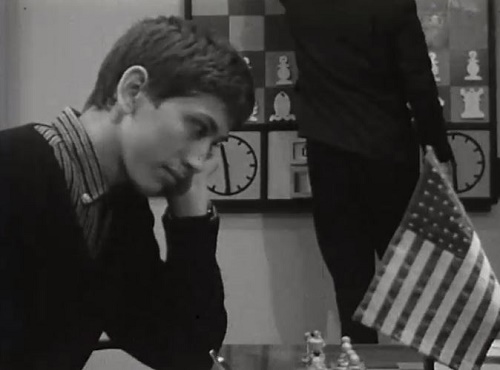
Bobby Fischer
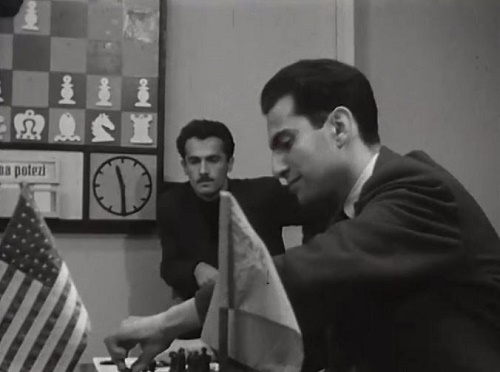
Mikhail Tal
(9886)
A British Pathé report (beginning at 0’57”) on the 1938 US championship, New York, April 1938, including footage of Reshevsky and Fine.
Olimpiu G. Urcan writes:
‘In addition to audio files with Keres interviews and speeches, the Estonian Film Archives contain a significant number of film files featuring him, and some of the material has been digitized and made available on-line. Among the highlights: a 1938 clip of Keres in a tournament (and playing blitz). A 1941 feature on his mathematics examination at the University of Tartu:
1945 film showing Keres in tournament play (with other Soviet masters):
There is a seven-minute montage on the 1947 USSR Championship, and a brief 1956 clip showing Keres in a simultaneous exhibition at a house of pioneers in Tallinn. Also, coverage of his golden jubilee celebration (1966) and remarkable 1975 footage of his funeral:’
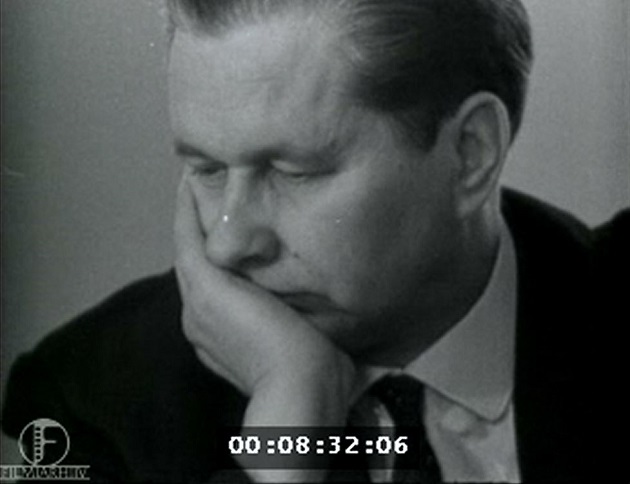
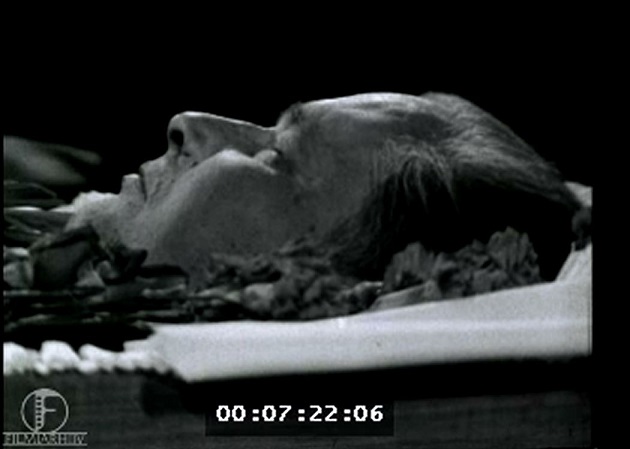
(9892)
Mr Urcan has also drawn attention to Das Bundesarchiv, which has a film report dated 25 May 1951 showing Bogoljubow at Bad Pyrmont.
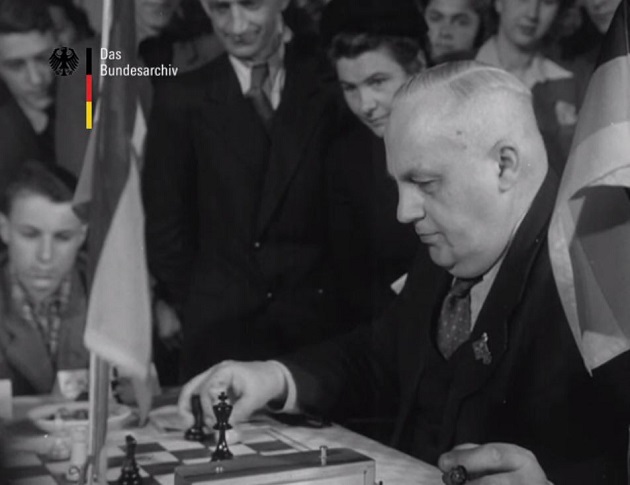
A further item pointed out by Mr Urcan is a France Actualités feature dated 22 January 1943 with, beginning at about 7’10”, a chess sequence which includes footage of Alekhine giving a simultaneous exhibition in Prague:
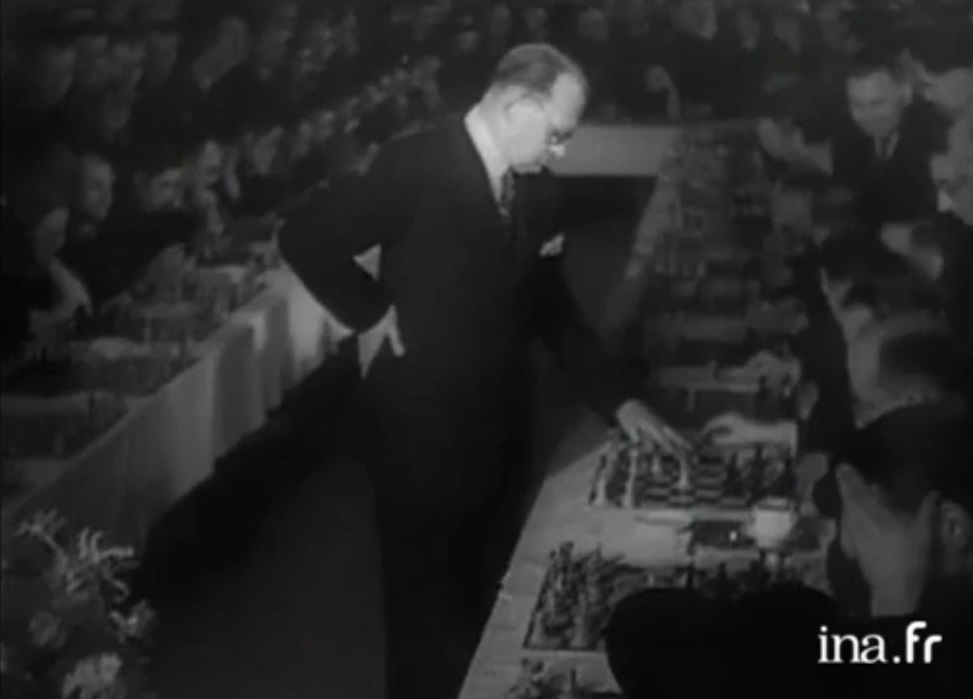
A large amount of Russian-language footage from the 1950s to the 1990s can be viewed by searching with the word ‘chess’ at the Net Film website.
Two further contributions from Olimpiu G. Urcan: an informal Bogoljubow v Euwe game in 1928 and the opening of the 1956 Candidates’ tournament.
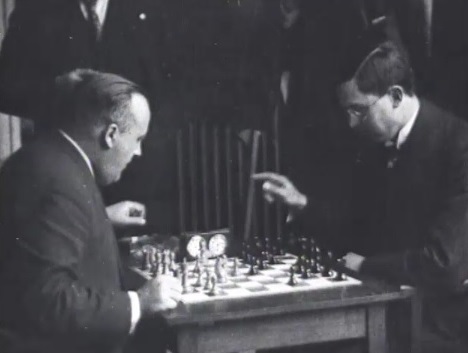
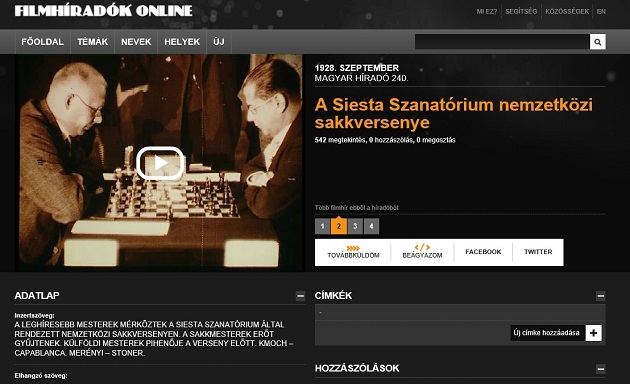
Olimpiu G. Urcan notes that a search for sakk on the Magyar Világhíradók website provides film coverage of Budapest, 1928 (notably featuring Capablanca) ...

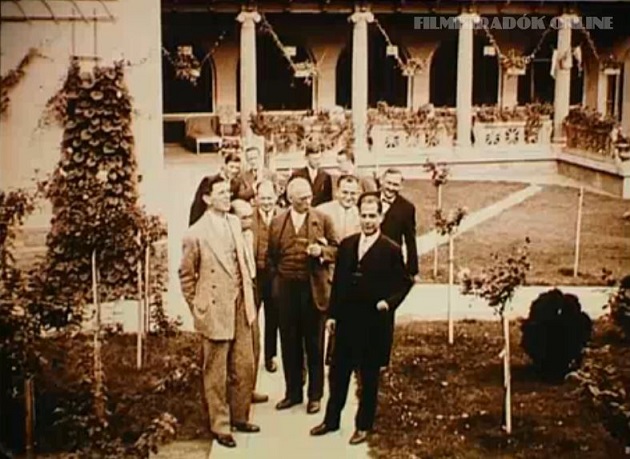
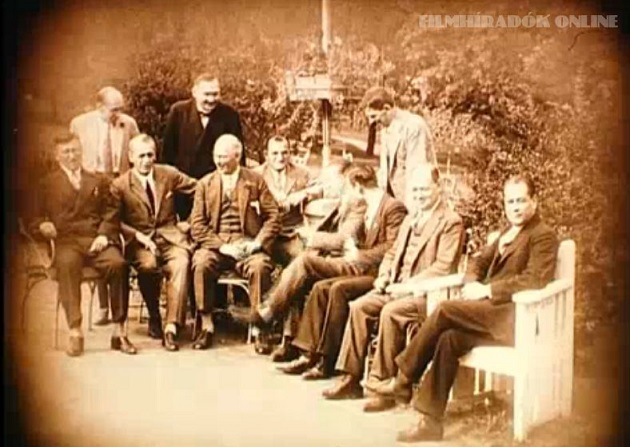
... as well items with footage of Maróczy, Réti, Rubinstein and Tartakower.
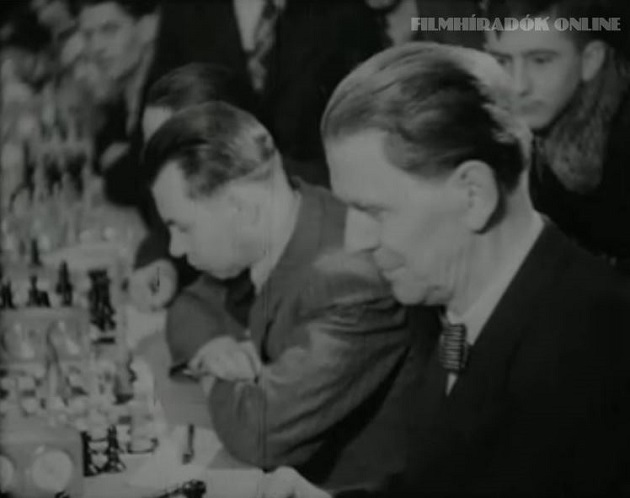
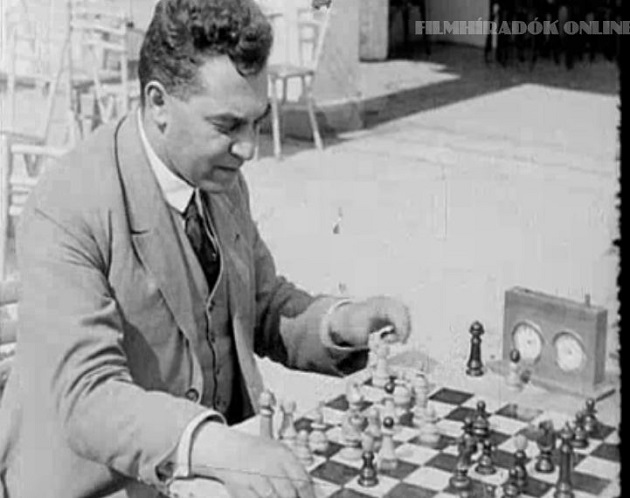
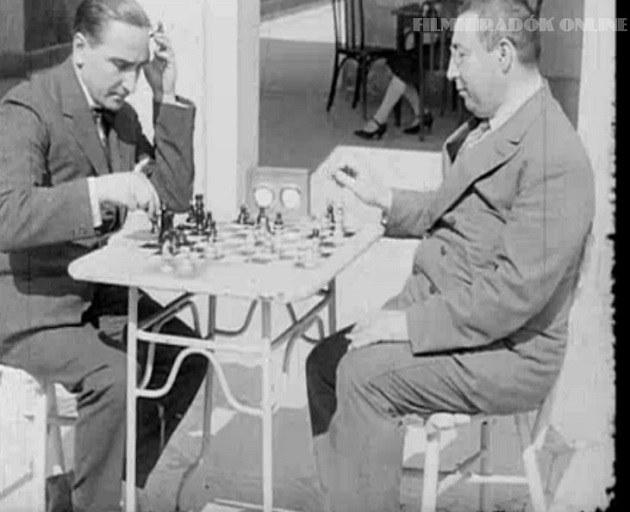
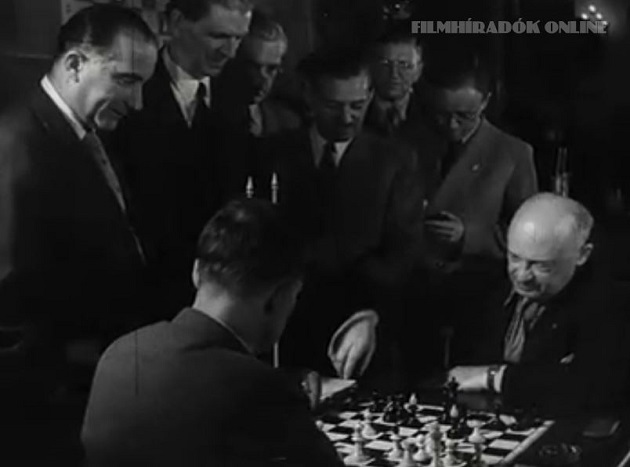
(10764)
From Olimpiu G. Urcan:
‘The Swiss Federal Archives have some rare chess footage, including an 84-second segment on the last round and prize ceremony of the Candidates’ tournament in Switzerland on 23 October 1953. It features, among others, Bronstein, Keres, Reshevsky, Smyslov and Taimanov.’
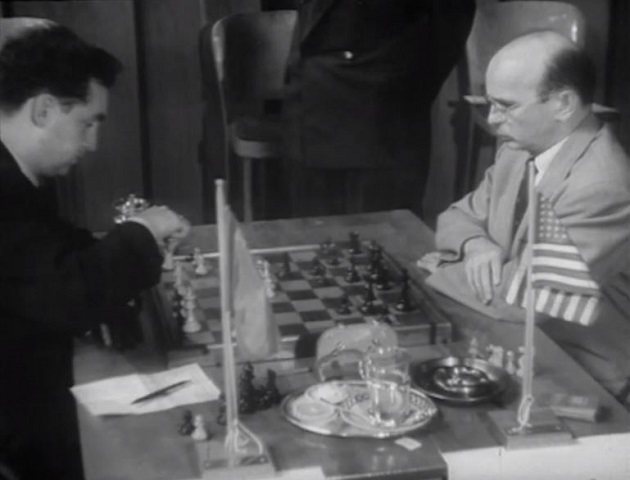
Mark Taimanov and Samuel Reshevsky
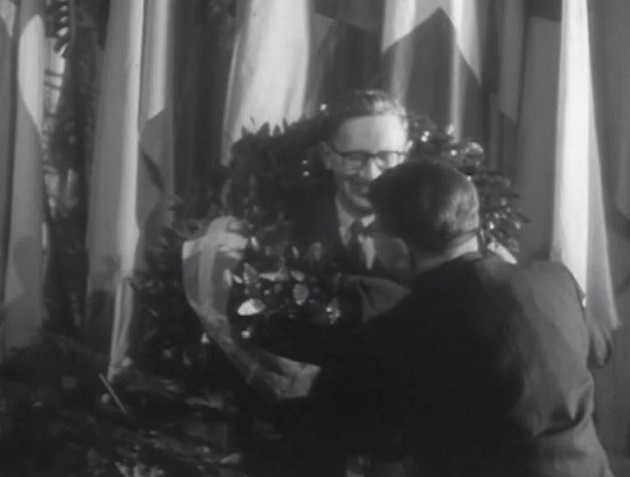
Vassily Smyslov
(10905)
Drawing attention to a Dutch news film report (5 January 1956), Wijnand Engelkes comments:
‘In his 1955-56 match against Donner for the Dutch championship, Euwe had just won the seventh game, taking a strong lead. In the film report his daughter Caroline explains that she and her sisters have teased their father by turning objects in his house upside down, threatening to leave them like that if Donner were to win the match. Donner said that if he won, he would go to Euwe’s house and remove most of the hideous furniture.’
The second screen-shot, below, is from further footage of the Euwe-Donner match:
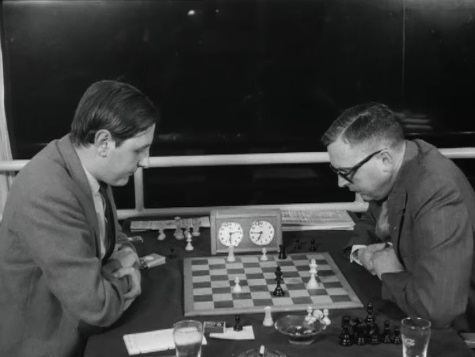
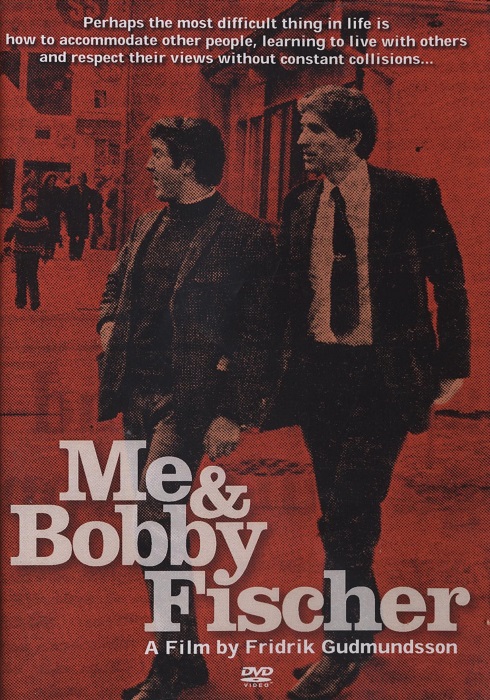
Michael Clapham has been watching the film by Friðrik Guðmundsson Me & Bobby Fischer, which is available on DVD:
‘It has over an hour of Fischer talking, in 2005, about such matters as his aborted match with Karpov, his time in prison, his views on Jews, and pre-arranged games.’
(11085)
We add a film clip of Purdy giving a simultaneous display. An announcement of the event was on page 41 of Chess World, 1 February 1951:
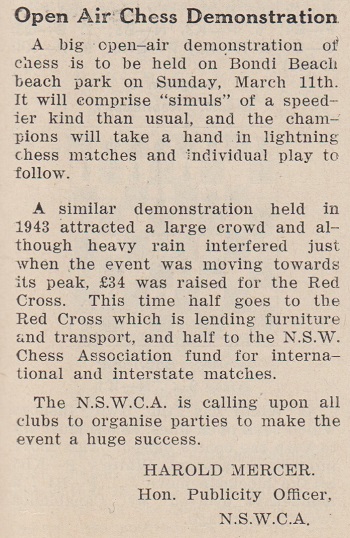
(11673)
Some footage of János Flesch playing blindfold chess.
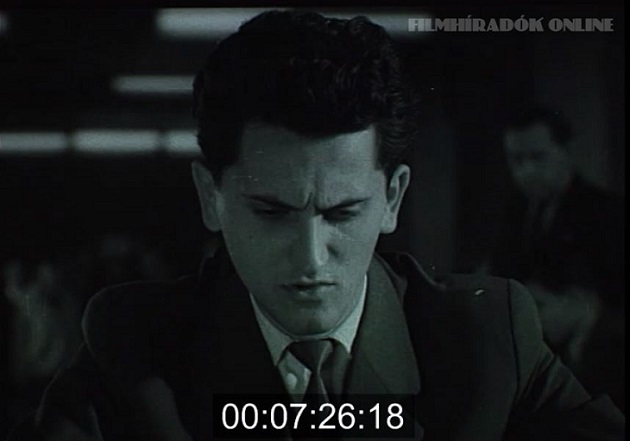
(11676)
See also Chess and Hollywood and Chess and Television.
To the Chess Notes main page.
To the Archives for other feature articles.
Copyright: Edward Winter. All rights reserved.